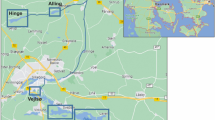Abstract
We used red shiner (Cyprinella lutrensis) as a model to examine ecosystem effects of water column stream minnows (Cyprinidae) in experimental streams. Benthic primary productivity, benthic invertebrate abundance, water column nutrient concentrations, size distribution of benthic particulate organic matter (BPOM), and sedimentation rates were measured across a range of fish densities (0–26.6 fish m–2) over a 35-day period. In addition, effects of fish density on algal standing crop and benthic invertebrates in experimental streams were examined over a longer time span (156 and 203 days). After 35 days, benthic primary productivity was positively associated with fish density, with an approximate three-fold increase in productivity between experimental streams stocked with no fish and those with 26.6 fish m–2. No effects on other ecosystem properties were detected after 35 days. Additionally, there was no effect on algal standing crop after 156 or 203 days and no effect on benthic invertebrates after 203 days. Because red shiners fed primarily on terrestrial insects, this experiment suggests that water column minnows can affect primary productivity in streams by transporting nutrients from terrestrial sources to the benthic compartment of the ecosystem. However, this effect may only be important in streams or during periods when nutrients are limiting.
Similar content being viewed by others
Author information
Authors and Affiliations
Rights and permissions
About this article
Cite this article
Gido, K., Matthews, W. Ecosystem effects of water column minnows in experimental streams. Oecologia 126, 247–253 (2001). https://doi.org/10.1007/s004420000505
Received:
Accepted:
Published:
Issue Date:
DOI: https://doi.org/10.1007/s004420000505




